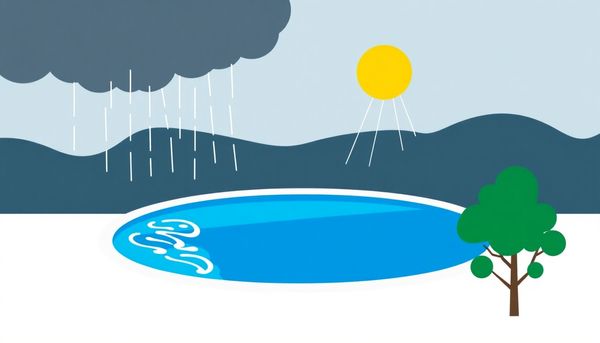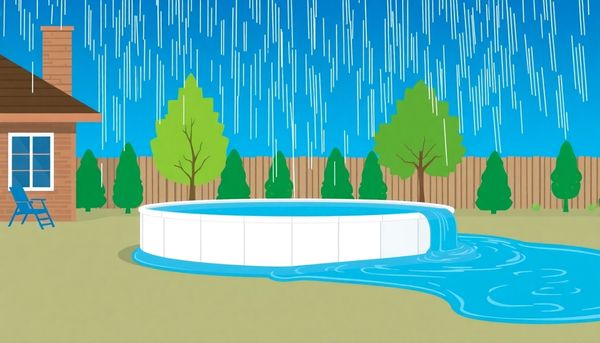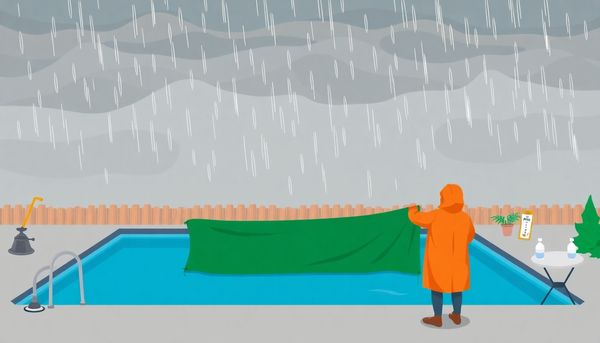How to Manage Pool Water Levels After Heavy Rain
July 07th, 2024
July 07th, 2024
After a heavy rainstorm, your backyard might resemble a small lake with a pool in the middle, rather than the other way around. That shimmering oasis, usually a source of relaxation, can quickly turn into a watery headache. Pools, by design, are not meant to handle excessive water without some help. Whether it's preventing overflow onto your carefully manicured lawn or safeguarding the chemical balance you've meticulously maintained, knowing how to manage excess water is crucial.
Years ago, I faced a similar situation after a summer deluge left my pool on the verge of spilling over. I remember standing poolside, umbrella in hand, pondering over the best course of action. It was then that I realized the importance of having a clear, efficient plan. Many pool owners, especially newcomers, might feel overwhelmed at the thought of draining water, worried about damaging their investment or causing unintended havoc.
Understanding the process involves more than just switching on a pump. It requires insight into your pool's needs and the weather's whims. From assessing water levels to ensuring the drainage system is functioning correctly, each step plays a pivotal role. This guide will walk you through practical methods, helping you effectively manage your pool's water level after a rainstorm, ensuring that your backyard remains a place of serenity rather than stress.

When the clouds finally part and your pool resembles a miniature lake, it's crucial to tackle water drainage with finesse. First things first, assess the aftermath. A heavy downpour might have turned your pool into a precarious balance of excess water and diluted chemicals. Start by grabbing your trusty submersible pump. This gadget is a lifesaver, especially for larger volumes of water. Simply attach it to a standard garden hose, and position it at the pool's deepest point. This ensures that water is efficiently siphoned off without hassle.
Next, pay attention to your pool's skimmers. If they're submerged, they're not doing their job—sucking up debris before it becomes a nuisance. Lowering the water to reveal the skimmers not only helps with cleanup but restores your pool's self-cleansing capabilities. While the pump handles the bulk, gently use your hands or a plastic scoop to remove any debris that might have accumulated during the storm.
An often-overlooked aspect is checking your pool’s overflow drains, which can be a hidden treasure in managing water levels. Ensure they’re clear from obstructions to facilitate natural drainage. Once the excess water has been managed, it's time to recalibrate your pool's chemistry. Test kits become your best allies here, ensuring your pH levels and sanitizers return to optimal range. Engaging in these steps transforms post-storm chaos into a smooth, rejuvenating process.
As clouds gather ominously and the air becomes thick with the promise of rain, safeguarding your pool from the impending downpour becomes crucial. Before the first raindrop falls, taking some proactive measures can save you a wealth of trouble later. Start by removing any loose items around the pool area. Toys, garden furniture, and pool equipment can easily become projectiles in strong winds, or worse, end up submerged, complicating your cleanup efforts.
Securely store these items in a shed or garage, ensuring that they don’t end up in a neighbor’s yard or, more importantly, in your pool. This simple step not only protects your belongings but also prevents them from damaging your pool or causing safety hazards.
Next, addressing your pool’s chemical balance is wise. Add a dose of algaecide and make sure the water is balanced. It acts as a preemptive strike against the organic material that rain can introduce. This step might seem minor, but it could mean the difference between a simple skim and a full-scale pool shock.
Moreover, if your pool has a cover, take the time to securely fasten it. This will help keep debris out and reduce the amount of rainwater entering the pool. Covers are like shields; the better they’re secured, the less work you’ll have after the storm has passed.
Finally, consider lowering the water level slightly if heavy rain is forecasted. Not more than a foot, though, to avoid structural issues with your pool. Being prepared means less stress and more time enjoying your pool once the skies clear.
After a rainstorm, your pool deck often resembles a small battlefield, littered with leaves, twigs, and other debris. Clearing this mess not only beautifies your space but also prevents future headaches. Begin by grabbing a sturdy broom to sweep away any debris that accumulated on the deck. It's best to push everything away from the pool's edge to avoid it all falling back into the water. This method keeps unwanted bits from clogging your filtration system later on.
Next, give the deck a good rinse. A garden hose works wonders for washing away the finer dirt and particles that sweeping might have missed. Consider using a nozzle to control the spray pressure, ensuring you clean thoroughly without wasting water. If you have a power washer, it can make quick work of stubborn grime, especially if the rain has left a layer of mud.
Once the deck is clear, turning your attention to the pool itself is crucial. With a leaf net attached to a telescopic pole, scoop out leaves and larger debris from the pool’s surface. This not only prevents clogging but also keeps your water inviting and clear. For those stubborn bits that sink to the bottom, a pool vacuum or automatic cleaner becomes your best ally. These tools ensure that your water remains crystal clear, ready for the next swim once the sun returns.
After the storm clouds have dispersed, there’s a crucial task that often gets overlooked: adjusting the pool's chemistry. Storms, particularly those carrying heavy rain, bring more than just an influx of water. They introduce various contaminants that can upset the delicate chemical balance of your pool. It's not just about removing excess water; it’s also about restoring the pool to a healthy state.
First off, take a moment to assess the water’s clarity and feel. If you've ever noticed a slight cloudiness after a storm, it's likely due to debris and diluted chemicals. Grab your trusty test kit and dive into checking levels of pH, alkalinity, and chlorine. A significant drop in pH is common, caused by the acidity of rainwater. This imbalance can be corrected by adding a pH increaser until the water returns to ideal levels (between 7.4 and 7.6).
Equally important is evaluating your pool's chlorine levels. Rain tends to lower chlorine, leaving your pool susceptible to bacteria and algae. If necessary, increase the chlorine to maintain its protective role. Alkalinity, too, might need a boost if it's been reduced by the rain’s impact.
Finally, consider adding a shock treatment, although it's not always necessary; doing so can be a proactive measure to ensure any unwelcome microorganisms are swiftly dealt with. Think of it as giving your pool a fresh start. With these adjustments, your pool will be ready for the next sunny day, inviting swimmers with its sparkling, balanced waters.

After the storm has passed and you've cleared away excess water, it's crucial to restore your pool's chemistry to its balanced state. A rainstorm can significantly disrupt the delicate balance of pool chemicals, turning your crystal-clear oasis into a potential breeding ground for algae and bacteria. Begin by testing the water with reliable test strips or a liquid test kit. This will give you a clear snapshot of the current chemical levels, including pH, alkalinity, and chlorine.
Rainwater, often slightly acidic, can lower the pool's pH, so be prepared to adjust it back to its ideal range, typically between 7.2 and 7.6. Alkalinity acts as a buffer for pH, and any major imbalance here can lead to fluctuations that might damage pool surfaces and irritate swimmers' skin. If needed, add sodium bicarbonate to increase alkalinity.
Next, inspect the chlorine levels. Rain can introduce organic contaminants, causing the chlorine to deplete as it works to sanitize the pool. Boost the free chlorine level if necessary, ensuring it’s around 1-3 ppm, which is considered safe and effective.
Don't overlook calcium hardness and stabilizer levels (cyanuric acid). These can also be diluted by heavy rainfall. Calcium hardness should typically be between 200-400 ppm to prevent corrosion and scaling. For cyanuric acid, aim for 30-50 ppm to protect chlorine from being broken down by the sun.
By carefully adjusting these parameters, you ensure that your pool remains a safe and inviting spot for relaxation, even after nature's interruptions.
When raindrops morph into a downpour, bringing along an unwelcome assortment of leaves, twigs, and dirt, the sight of your pool can quickly shift from serene to chaotic. This debris isn’t just unsightly; it can also mess with your pool’s balance and functionality. Here's how to tackle it with finesse.
Start by clearing your pool deck, brushing away any debris that might inadvertently find its way into the water. A simple sweep followed by a rinse with a garden hose can make all the difference. Personally, it’s a ritual I’ve learned to embrace; a few moments spent here save hours of skimming later.
Next, equip yourself with a reliable leaf net attached to a telescopic pole. Skim the surface of your pool with care, capturing leaves and other floating debris. Skimmer baskets should not be overlooked; empty them to ensure the filtration system is primed for action. My trusty leaf net, a gift from a fellow pool enthusiast, has saved me countless headaches.
Should the storm have left the pool floor littered, it’s time to bring out the big guns. A quality pool brush will help push debris toward the drain, streamlining the cleaning process. If manual labor isn’t your style, an automatic cleaner can shoulder the burden, provided the debris isn’t excessive. When manual vacuuming becomes necessary, remember to switch your filter to “waste” mode. This will not only keep your filter from clogging but also aid in lowering your water level to its rightful place.
With the debris out of the way, your pool’s health is halfway restored. As I’ve learned, taking these steps ensures that when the sun peeks back through the clouds, your pool is ready for a splash, without the mess.
Managing water levels in your pool after a significant downpour is crucial, not only for preserving your pool’s structure but also for maintaining optimal water chemistry. After a particularly heavy rainstorm, you might notice your pool water creeping perilously close to the brim. It’s not just about aesthetics; overflowing water can damage your pool deck and affect the skimmer's efficiency.
I remember last summer when a surprise thunderstorm rolled through our neighborhood while I was on vacation. By the time I returned, the pool water had risen above the skimmer, rendering it useless at clearing debris. I quickly learned the importance of addressing high water levels. The first step is to assess the situation: if your skimmer is submerged, it’s time to take action.
To safely adjust the water level, you can begin by setting your pool filter to “waste”. This diverts water directly out of the pool without passing through the filter, preventing unnecessary wear on your system. Using a backwash hose attached to the filter’s waste port can help efficiently lower the water. Alternatively, a sump pump connected to a garden hose is another effective method. Always ensure the water is discharged to a suitable drainage area to avoid flooding your garden or affecting local sewage systems.
Remember, balancing the chemistry is equally vital after draining. Rainwater can significantly dilute the chemicals in your pool, so once you've adjusted the water level, test and rebalance it. This way, your pool is not only at the right level but also safe and clean for your next swim.
After a heavy rain leaves your pool resembling a small lake, restoring its chemistry becomes essential. Rainwater, often slightly acidic, can disrupt the delicate chemical balance, turning your pool into a potential breeding ground for algae and bacteria. Start by testing your pool's water to determine the immediate effects of the rain. Use test strips or a liquid test kit for a comprehensive check-up of pH, alkalinity, chlorine, and calcium hardness levels.
A keen eye on pH is necessary as rain can lower it, disturbing the water’s overall balance. If the pH is off, the alkalinity might also require adjustment. Ideally, the pH should sit between 7.2 and 7.8, ensuring a comfortable swim and effective chlorine operation. Speaking of chlorine, this is your pool’s frontline defender against contaminants introduced by the rain. Make sure there's enough free chlorine available to tackle any unwanted invaders.
Don’t overlook cyanuric acid; rain often dilutes this stabilizer, leaving your chlorine less effective. Restoring the right level will help protect the chlorine from being broken down by sunlight. If your pool’s chemical levels seem daunting to adjust, consider consulting a professional or a local pool store. With precise balancing, your pool can regain its sparkling, inviting charm, ensuring every swim is a pleasant one. Keep these strategies at hand, and you'll always be prepared to handle nature’s whims with a smile.

After the storm has passed, the first step to restoring your pool's pristine condition involves debris removal. Leaves, twigs, and other unwanted visitors often find their way into the water, creating a murky mess that not only affects aesthetics but also pool health. A family friend once shared how a single storm turned their crystal-clear pool into what looked like a leafy soup. This underscores the importance of acting promptly.
Begin by sweeping the pool deck to clear away any debris that might otherwise be blown back into the water. A good broom and a garden hose can work wonders in tidying up the area. Next, equip yourself with a leaf net or a flat skimmer attached to a telescopic pole. This simple tool is your ally in scooping up floating debris from the water’s surface, preventing it from sinking and complicating the cleanup process.
Inspect the skimmer and pump baskets, as they may have already collected a fair share of leaves and twigs. If clogged, these components can impede the filtration system's ability to circulate water effectively. If necessary, do not hesitate to get your hands dirty and manually clean out these baskets to ensure optimal performance.
For any debris lingering at the bottom, use a sturdy pool brush to corral it towards the main drain or a central location for easier vacuuming. By diligently removing debris, you pave the way for clearer water, setting a strong foundation for the next steps in maintaining your pool’s health and balance.
When the clouds gather and the winds start to whistle ominously, it's prudent to have a strategy in place for safeguarding your pool. Nobody wants to wake up to a murky mess after a storm. First, clear the surrounding area. Items like pool toys, loungers, and umbrellas should be securely stored away to prevent them from becoming unwanted pool guests. I once neglected this step, and my neighbor found my floaty two houses down—lesson learned.
Switch off your pool equipment to protect it from potential electrical surges. It's a simple precaution that can save you from costly repairs. If your pool has covers for the pump or heater, now's the time to use them. They provide an additional layer of defense against the elements.
Think about treating your pool water before the storm hits. Balancing your pool chemistry and adding a dose of algaecide can help fend off organic intruders introduced by rainwater. Although not mandatory, these steps ease the post-storm cleanup, ensuring you’re not dealing with a green swamp.
Finally, consider lowering the pool water level slightly. This preemptive measure accommodates the expected influx of rainwater, keeping the skimmers operational. But remember, don’t go overboard; lowering by about a foot is usually sufficient to avoid pressure issues. With these preparations in place, you can enjoy the storm from the safety of indoors, knowing your pool is ready to weather the blow.
After a rainstorm, the surface of your pool might resemble a miniature forest floor. Leaves, twigs, and other debris are not just unsightly; they can wreak havoc on your pool’s chemical balance. Once the skies have cleared, grab your trusty leaf net or skimmer attached to a telescopic pole. Glide it gently across the water, capturing assorted debris before it sinks to the bottom, where it becomes a bigger hassle.
Years of pool ownership have taught me that speed is crucial. Letting debris linger too long not only complicates cleaning but can also promote algae growth. On windier days, I've found myself skimming the pool multiple times just to keep up with nature’s onslaught. If your skimmers are still submerged post-storm, manually clearing them helps restore their function once the water level is adjusted.
A garden hose can be an unexpected ally in this battle. Use it to rinse off any dirt and debris from the pool deck, always spraying away from the pool. This prevents unwanted particles from sneaking back into the water. Remember, tackling the surface mess is just the beginning. Ensuring your pool’s filtration system is free from clogs is equally important, so don’t forget to check and empty skimmer and pump baskets.
This routine may seem tedious, but taking immediate action helps maintain a pristine pool, ensuring it's ready for use as soon as the sun reappears.
Raindrops may seem harmless, but when they accumulate in your pool, they can transform your backyard oasis into an overflow hazard. After the storm clouds clear, safely draining excess water is crucial to restoring balance and protecting your pool equipment. Start by ensuring your pool's filtration system is ready for action. Remove any debris clinging to the skimmer and pump baskets. This step is essential because clogged baskets can impede water flow when you turn the filter to the "waste" setting, which is key for effective drainage.
Next, if you find yourself ankle-deep in excess water, employing a submersible pump can be a lifesaver. Attach it to a garden hose, making sure the other end of the hose is directed to a suitable drainage area far from the pool’s perimeter. A well-placed pump can rapidly reduce water levels, but keep a keen eye on the gauge; you want to stop once the water drops to mid-skimmer level.
Alternatively, your pool’s multiport valve offers a nifty "backwash" function that serves dual purposes—clearing the filter and lowering water levels. Before using this method, check local regulations to ensure compliance with water disposal rules. Draining can be a balancing act of maintaining enough pool water to protect against hydrostatic pressure, while also removing the surplus. Always remember, safety first: don’t rush the process, and keep electrical equipment far from any dampness to avoid mishaps. In no time, your pool will be back to its crystal-clear self, ready for the next sunny swim day.

When storm clouds begin gathering, a little preparation can safeguard your pool from turning into a leaf-laden disaster zone. It starts with a quick survey of the area. Anything that isn’t anchored down, such as pool toys, outdoor furniture, or decorative items, should be moved indoors. This reduces the risk of these objects becoming airborne projectiles in gusty winds, and it keeps them from cluttering your pool.
Next, consider the state of your pool cover. If the storm forecast includes heavy winds, it might be best to leave the cover off to prevent it from tearing. On the other hand, a securely fitted cover can shield your water from falling debris and excess rainwater. Evaluate your cover’s condition and decide accordingly.
An often-overlooked prep step involves the pool’s chemistry. Balance the water, paying extra attention to pH and alkalinity levels, and consider adding a dose of algaecide. Doing so provides a buffer against rain-induced imbalances and organic debris that may find its way into the pool.
Finally, think about your pool equipment. Power down the pump and filter, and make sure any automated timers are disabled to avoid accidental activation during the storm. Using covers for the equipment, if available, can offer additional protection against the elements. With these steps, your pool will be better braced to handle whatever the weather throws its way.
A sunny afternoon by the pool can quickly turn into a challenge when unexpected rain pours down, threatening to overflow and invite chaos. But before reaching for the sump pump, there's something even more crucial—ensuring the pool area is secure. Indeed, the first shield against turmoil is preparedness.
Start by evaluating the perimeter. Loose objects like patio chairs or garden toys can transform into unwanted pool guests during a storm. Secure them in a shed or garage. Not only does this prevent damage, it also reduces subsequent cleaning efforts. A friend of mine once learned this the hard way when his favorite pool float ended up in a neighbor’s yard, never to return.
Next, assess the pool’s electrical components. If the forecast looks grim, switch off the pump and any electrical devices. Most pools are equipped with reliable systems to handle water, but electricity and water’s volatile mix is best avoided. If you have protective covers for your pump and other equipment, now is the time to use them.
To further safeguard your pool’s chemistry, consider adding a bit of algaecide before the storm hits. This proactive measure can help minimize the algae bloom that often follows an infusion of rainwater. By taking these steps, not only do you protect your pool’s integrity, but you also set the stage for a simpler cleanup once the skies clear.
Storms have a way of leaving behind more than just memories; they often deposit a mess of debris into your once-pristine pool. Handling this clutter efficiently is crucial, not only for the sake of aesthetics but also for maintaining the health of your pool's ecosystem. You might remember last summer, a particularly wild storm hit my neighborhood. I had leaves, twigs, and even a few stray blossoms swirling around in my pool. It was a sight to behold—though not one you'd want to linger.
The first step is to tackle the visible mess on the pool surface. Armed with a reliable leaf net skimmer attached to a telescopic pole, start scooping out all the debris floating on top. If you’ve ever spent an afternoon fishing out every last leaf, you know the satisfaction of seeing the water clear up. Trust me, a deep and durable skimmer, perhaps one with a lifetime guarantee, can turn this chore into a surprisingly therapeutic activity.
Once the surface is clear, don’t forget the skimmer and pump baskets. These can easily become clogged, hampering your filtration system's efficiency. A pool skimmer—or even your hands, if you’re up for it—will do the trick. Remember, if power is out post-storm, manually clearing debris is vital to prevent it from settling at the bottom, adding hours to your cleaning efforts later. Equipped with the right tools and strategies, you’ll soon have your pool back to its sparkling self, ready for the next sunny day.
When the skies unleash their fury, and your pool resembles more of a mini-lake, it's time to take action. Draining excess water from your pool isn't merely about aesthetics; it's a vital step to ensure the longevity of your pool equipment and maintain balanced water chemistry. Begin by assessing the state of your pool's water level. If recent rains have left your skimmers submerged, it's essential to act quickly.
First, switch your pool pump to the "waste" setting, which allows water to bypass the filter. Connect a backwash hose to the appropriate port, ensuring that the hose leads to an area where water can safely drain, away from your home's foundation. This method will effectively lower the water level while preventing debris from clogging your filtration system.
For those with a sump pump, it's a handy ally in this watery battle. Attach it to a garden hose, submerge the pump, and let it efficiently siphon out the excess water. Keep a watchful eye on the water level; your target should be halfway up the skimmer opening.
Throughout this process, use this opportunity to inspect your pool's surroundings. Ensure no additional debris is poised to make an unwelcome splash. With the water level back to normal, recalibrate your pool's chemistry. This simple measure ensures your oasis remains crystal clear, ready for the next sunny day.
A torrential downpour can dramatically alter your pool's pristine balance. After the skies clear, it’s essential to reevaluate your water chemistry to ensure a safe swimming environment. Start by grabbing a reliable test kit. This small investment can save you from bigger headaches down the line. Test strips or liquid kits provide a snapshot of your pool's chemical landscape, helping you identify any significant shifts in pH, alkalinity, or chlorine levels.
Rainwater, often slightly acidic, tends to lower the pH of your pool. This can cause irritation for swimmers and corrosion to your pool equipment. Use sodium carbonate or baking soda to gently nudge your pH back to its sweet spot, usually between 7.4 and 7.6. Alkalinity often needs a boost too, as it acts as a stabilizer for pH levels. Adding a bit of baking soda can do wonders here.
Next, consider the sanitizer levels. Rainstorms can introduce contaminants, making your pool an oasis for bacteria and algae if left unchecked. Ensure your chlorine levels are adequate—typically 1 to 3 parts per million—to fend off these unwanted guests. If they dip too low, a dose of pool shock might be in order, preferably at dusk to maximize efficiency.
Lastly, take a moment to check calcium hardness and cyanuric acid levels. Both are crucial for keeping your pool water balanced and your equipment in prime condition. If you’re uncertain about doing it all solo, a trip to your local pool store can offer additional peace of mind. Restoring balance post-rain ensures clear waters and carefree swimming days ahead.
Navigating the aftermath of a rainstorm can be tricky, especially when it comes to safeguarding your pool equipment. The stakes are high; waterlogged machinery can lead to costly repairs, not to mention the hassle of downtime when you'd rather be swimming. After a storm, it's crucial to act swiftly to prevent equipment damage, starting with an assessment of water levels.
Too much water can submerge the skimmer and other vital components, hindering their function and increasing the risk of electrical short circuits. Before hitting the panic button, ensure your pool pump is switched off during draining. This simple step can save your pump from running dry or dealing with potential airlock issues, which might occur when water levels drop unexpectedly during drainage.
Once the excess water is removed, turn your focus to the filter system. Clean out all skimmer and pump baskets, and give attention to the filter itself. Debris can easily clog these areas, reducing efficiency and forcing your system to work harder than necessary. Remember, even if your filter appears fine, a thorough backwash or cleaning may be warranted after heavy rains.
Lastly, keep an eye on your pool cover, if you have one. A sagging cover filled with rainwater can exert undue pressure on the pool's edges and equipment surrounding it. By promptly draining rainwater and removing debris, you're not just facilitating a quicker return to clear waters; you're ensuring your equipment remains in tip-top shape.

This article provided insights into maintaining your pool. Start your pool care journey today!
Want to become a pool maintenance expert? Our free Pool School course covers everything you need to know about pool care. From basic maintenance to advanced troubleshooting, you'll learn how to:
Join over 10,000 pool owners who have already transformed their pool care routine. Get started with our free Pool School course today!